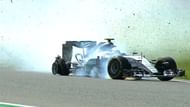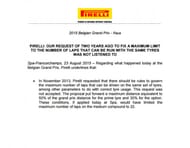The recently-concluded Belgian Grand Prix, regarded as one of the best on the Formula One calendar, saw Briton Lewis Hamilton of Mercedes AMG Petronas take a smooth victory after qualifying in pole.
Spa-Francorchamps is a dramatic circuit with its long, high-speed straights, heights and sharp turns enjoyed by drivers, bosses and spectators alike. But this year’s race was eventful for several wrong reasons, too. Three incidences of tyre issues created problems – for Nico Rosberg at practice, and most notably for both Scuderia Ferrari drivers, Kimi Raikkonen and Sebastian Vettel.
Four-time world champion Vettel, who was poised to finish with a podium at the Belgian GP, had the most disastrous, and potentially dangerous problem. On softs and racing the final two laps, Vettel was just ahead of the track’s highest speed corner, Eau Rouge, when his rear right tyre exploded completely. He limped on to retire from the race, and French driver Romain Grosjean of Lotus, who had been trailing Vettel, took third instead.
Had his tyre blown out at Eau Rouge, Vettel would have been trapped on one of Formula 1’s highest speed straights.
Both Germans – Vettel and Rosberg – openly came out against tyre manufacturers Pirelli, saying the issues were ‘unacceptable.’
The Italian tyre manufacturers, who have long been openly favoured by Formula One supremo Bernie Ecclestone, released a statement today saying they have “conducted rigorous testing” and that there had been no “issues with structural integrity.”
Fingers were pointed at Ferrari’s one-stop strategy at the Grand Prix yesterday, alleging this was the primary cause of Vettel’s troubles. It may have been easier to blame Ferrari alone if this had been an isolated incident, but following tyre issues for Raikkonen, for whom a cut mysteriously appeared on his tyre, or Rosberg’s tyre completely exploding, the tyre makers have a lot to answer for.
An incensed Vettel went on a profanity-laden tirade against the tire manufacturers following the race, trying to emphasize how dangerous it could have been for him had the blowout actually happened. It can go horribly wrong, as demonstrated here, during the Radical Euromasters race of Marcello Marateotto at the 600 km Circuit de Spa-Francorchamps meeting in 2014:
Luckily, the driver survived.
Considering, however, that speeds in F1 are higher and cars have far more force, the error could have gone disastrously wrong for the 4-time champion, who said himself he ‘may not have been standing there if the crash had happened a few metres earlier.
The Italian tyremakers, while obviously desirous of absolving themselves of all blame, have also complained that they submitted a proposal to motorsport governing body FIA about how many laps could be run on a set of tyres, along with “other parameters pertaining to tyre usage,” but these fell on deaf ears.
However, this still does not explain Raikkonen’s ‘random’ cut or Rosberg’s blowout, both of which were subject to similar track conditions and temperatures.
French tyre manufacturers Michelin have submitted a bid to enter Formula One next year, and considering the troubles with Pirelli, it may be possible a new door has opened up for the makers to enter.
Pirelli has also alleged they do not receive enough testing for tyres – this is a major factor that needs to be accounted for, especially considering new FIA regulations have also brought vehicle testing time down drastically. This comes despite the FIA saying they wish to mke F1 “safer” for drivers.
A possible solution to this would be to increase testing for Pirelli, and the funds for this could be contributed to by teams themselves. Data from this testing could then be distributed among teams.
For now, it seems the FIA have instructed Pirelli to manufacture tyres that degrade, but not too much, and are able to withstand the heavy load of an F1 car, which is often in the range of ~800kg while still being light enough to not significantly affect the aerodynamics of the vehicle.
Both manufacturer and FIA are partly to blame, it would seem, and they will need a more symbiotic relationship if F1 is to truly become safer in the future.


